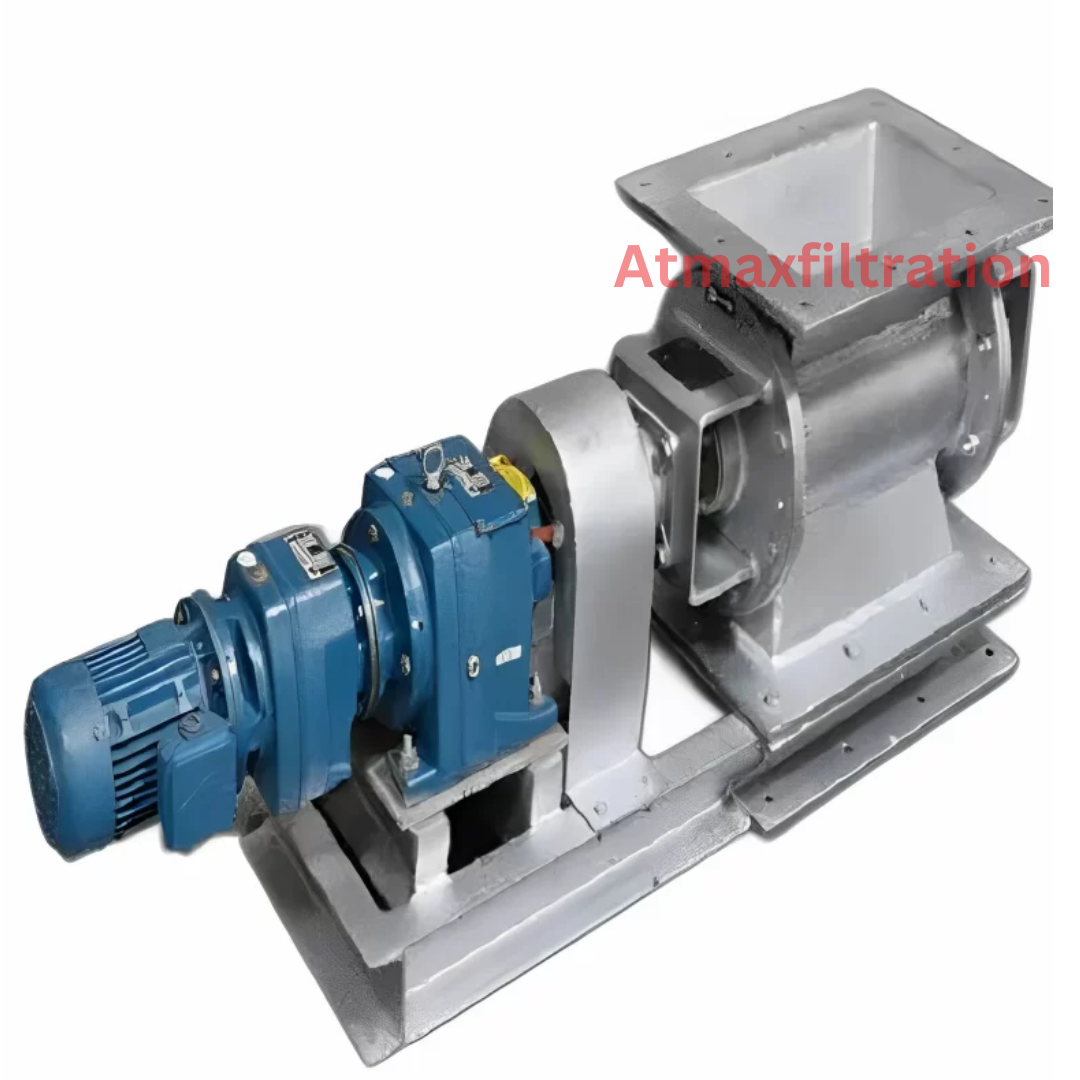Rotary Air Lock
Rotary Air Lock

The primary function of a Rotary Airlock Valve is to control the flow of solid materials, such as powders or granules, while maintaining an airlock condition. The device typically features a rotating element (rotor) with multiple vanes or blades within a cylindrical chamber. As the rotor turns, it picks up material from the inlet, moves it through the chamber, and discharges it at the outlet.
This process controls material flow and prevents air from passing between the inlet and outlet, crucial for maintaining pressure differentials in certain systems.
Rotary Airlock Valves are widely used in industries like agriculture, chemical manufacturing, and food processing, where efficient and controlled handling of bulk materials is essential. Atmax Filtration also supplies stainless steel and ATEX certified Rotary Air Lock Valves.
Rotary Airlock Valve Specifications
- Opening Size: 150-600 mm
- Flange Opening: Square / Round
- Differential Pressure: Capable of handling higher pressures
- Temperature: Built to withstand high temperatures
- Drives: Chain Driven / Direct Drive
- Material of Construction: Carbon steel, stainless steel (202, 304, 316, 410), and cast iron
- Rotor: Open fabricated type
Types of Rotary Airlock Valves
Blow Thru Rotary Airlock Valve
- Features: Allows material to pass through without obstruction, ideal for pneumatic conveying applications.
- Advantages: Minimizes material damage and air leakage, low maintenance.
- Disadvantages: Not suitable for very abrasive materials.
2. Drop Through Rotary Airlock Valve
- Features: Material drops through rotor pockets directly into discharge, effective for handling dry bulk materials.
- Advantages: Simple design, efficient material transfer with minimal energy consumption.
- Disadvantages: Less effective for sticky or cohesive materials.
- Specifications:
- Opening Size: 150, 200, 250, 300 mm
- Material of Construction: Cast Iron
- Capacity Range: Up to 33 m³/hr
- Differential Pressure: Up to 20 kPa
- Temperature Rating: Up to 200°C
Quick Cleaning Rotary Airlock Valve
- Features: Designed for easy disassembly and cleaning, suitable for industries like food, dairy, and pharmaceuticals.
- Advantages: Reduces downtime for cleaning, ensures compliance with hygiene standards.
- Disadvantages: Higher initial cost due to specialized design.
Heavy Duty Rotary Airlock Valve
- Features: Built to handle abrasive and heavy materials, constructed with robust materials.
- Advantages: Long lifespan, durable in harsh conditions.
- Disadvantages: Higher weight and cost, increased power requirements.
Direct Drive Rotary Airlock Valve
- Features: Motor directly coupled to rotor shaft, eliminating belts or chains.
- Advantages: Reduced maintenance, efficient power transmission.
- Disadvantages: Limited flexibility in speed adjustment.
Belt Drive Rotary Airlock Valve
- Features: Utilizes a belt and pulley system to drive the rotor.
- Advantages: Flexible and easy to adjust operational speeds, lower initial cost.
- Disadvantages: Higher maintenance, less efficient power transmission.
NFPA Rotary Airlock Valve
- Features: Designed to meet NFPA standards, used in applications where fire and explosion safety are critical.
- Advantages: Ensures compliance with safety regulations.
- Disadvantages: Higher cost due to specialized design.
Dust Collector Rotary Airlock Valve
- Features: Designed for use in dust collection systems, maintains an airtight seal to prevent dust escape.
- Advantages: Maintains air quality, reduces maintenance costs.
- Disadvantages: May require frequent maintenance in very dusty environments, higher cost for specialized designs.
Atmax Filtration Elements Inc is a leading supplier of Rotary Air Lock Valves, and Screw Conveyors in New Jersey, USA. Atmax also supplies RAVs in Saudi Arabia, Dubai and UAE, Kuwait and many more countries. For more information, you can reach us at (816)-745-9994 or write to sales@atmaxfiltration.com
Product Tags
Latest Blog
- How to Perform TABB (Testing, Adjusting, and Balancing) for Food Processing Facilities
- The Science Behind Commercial Kitchen Airflow and Ventilation
- How to Extend the Life of Your Restaurant Kitchen Ventilation System
- Benefits of Using a Surface Grinder Dust Collector
- Methods to Reduce Energy Consumption in Ventilation & HVAC Fans
